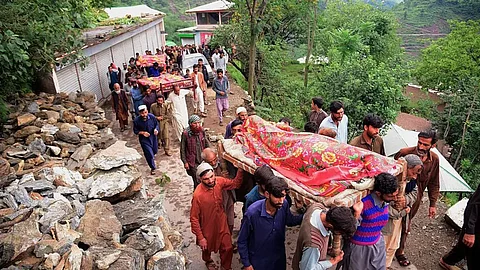

MUZAFFARABAD: The ongoing monsoon season has caused unprecedented damage across Pakistan-administered Kashmir, with at least 22 lives lost, 28 people injured, and over 800 houses damaged, according to Chaudhry Fareed, Secretary of the State Disaster Management Authority (SDMA).
Fareed said the Muzaffarabad Division has been hit the hardest, followed by Poonch and Kotli in the Mirpur Division.
“Infrastructure damage includes 26 powerhouses, 33 bridges, 200 kilometers of roads under local government control, and nearly 100 kilometers of roads under the Communication and Works Department. Additionally, four schools, several health facilities, 40 irrigation channels, and 59 water supply schemes have been affected. The estimated financial loss stands at Rs. 8 billion,” he added.
Fareed also said that the disaster response has involved some of the largest rescue operations in AJK’s history. At Ghalti Kully, 700 stranded people were successfully rescued, fed, and provided with travel arrangements. He confirmed that no bodies remain missing, and all deceased have been recovered.
“This was a massive operation. Countless people were rescued from dangerous areas under extreme conditions,” he said.
Among the most tragic incidents, he noted, was in Tehsil Naseerabad, where six members of a single family—including mother, father, and four children—died.
In Taobutt (Neelum Valley), a mother and father from Karachi were killed in a jeep accident, while their young daughter was rescued and safely returned to her family.
In Rawalakot, a women professor with a PhD from the USA, who was part of the local faculty, also lost her life.
Fareed also reported widespread damage to forests, and said the Noseri Dam was filled to capacity. A large amount of timber—both uprooted and cut—flowed into Pakistan-administered Kashmir from Indian-administered Kashmir via the Neelum and Jhelum rivers.
A serious public safety threat has emerged along the Line of Control (LoC), where landmines and explosive materials planted for security have been washed downstream.
“Explosive remnants, including missile fragments, have surfaced in various areas. We’ve launched a media awareness campaign to inform the public and prevent further casualties,” Fareed said. He added that under the government’s relief framework, families affected by the disaster are receiving financial aid, temporary shelter, food supplies, kitchen utensils, and medical kits.
Sardar Waheed Khan, Director General of the State Disaster Management Authority, warned that Pakistan-administered Kashmir is currently experiencing its seventh monsoon spell, expected to continue until August 22 or 23. He said additional eighth and tenth spells are forecast from August 23–30 and September 1–10, and these may be even more intense than previous ones.
“Initially, we estimated rainfall would be 20–25% above normal,” Khan said. “But now, updated assessments show a 70–75% increase. Some of this has already occurred, but more is expected.” He warned the region may face a worse situation next year, with 11–12 monsoon spells likely in 2026, and even greater intensity.
A key issue, he noted, is the localized nature of rainfall: “This year’s damage is largely due to cloudbursts in specific areas, which cause sudden flooding in streams. Widespread rain usually causes less damage, but localized events have been far more destructive,” he said.
“We are dealing with the most severe monsoon impacts in recent memory. If the current trends continue, disaster preparedness in Pakistan-administered Kashmir will need to scale up drastically,” Khan emphasized.
Have you liked the news article?